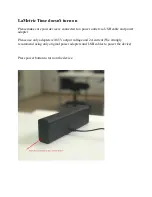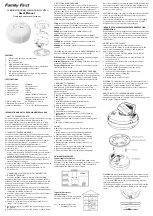
8
Note
•
Cigarette smoke will generally not trigger the alarm un-
less the smoke is blown directly into the smoke alarm.
•
Steam caused by cooking can trigger an alarm if the
smoke alarm is located close to a cooking area.
•
If an alarm is triggered, verify whether or not a genu-
ine emergency situation exists.
•
If fire or smoke is present, then call the fire brigade
and behave as described in
6.3 Behaviour when
alarm sounds (recommendation)
.
•
As soon as you have ascertained a false alarm, press the
TEST button on the smoke alarm to mute the alarm for
approximately 9 minutes.
•
The red LED will then flash every 10 seconds to indicate
that the smoke alarm is in mute mode.
•
The smoke alarm is automatically reset after approxi-
mately 9 minutes. If smoke particles are still present after
this time, the alarm will trigger again.
•
You can activate the mute mode repeatedly.
7.Care and maintenance
7.1 Test
Press the
TEST
button on the smoke alarm. The signal tone
sounds if the electronics, sensor, horn and battery are all
functioning properly.
Note
•
If smoke alarms no longer function correctly, replace
them with new ones immediately.
•
It is recommended to test the device on a weekly
basis in order to ensure that it functions properly.
•
Test the smoke alarm
ONLY
using the
TEST
button.
Never use a naked flame, lighters, and so on, to
simulate an alarm and verify correct functioning.
7.2 Alarm simulation
Press and hold the
TEST
button on the smoke alarm to sim-
ulate the alarm. The
LED
flashes once per second and an
alarm signal will sound until you release the
TEST
button.
7.3 Battery / changing the smoke alarm
The 3-volt lithium battery in this smoke alarm will last ten
years.
If the battery is weak, a signal tone will sound every
43 seconds. The LED flashes every 43 seconds.
A weak battery is indicated over at least 30 days. Replace
the smoke alarm with a new one in this time period.
You should endeavour to promptly replace the smoke alarm
with a new one!
Note
The smoke alarm itself (in particular, the sensor) likewise
has a certain life expectancy. Before installing the smoke
alarm, check the date it will need replacing (printed on it).
Change the smoke alarm on this recommended date, even
if there is still no indication of a weak battery.
7.4 Care
Clean the smoke alarm regularly (at least once a month) to
remove dust, dirt and debris.
Using a vacuum cleaner with a soft brush, carefully vacu-
um all sides and covers of the smoke alarm.
Check the smoke alarm for damages that could affect
proper functioning (for example, cracks in the housing). If
damages exist, replace the smoke alarm with a new one.
Make sure that all requirements corresponding to the
installation location (see
4. Assembly
) are observed. In
the case of structural or other recognisable modifications,
check whether the existing installation of the smoke alarm
still meets all relevant requirements. If necessary, adjust the
installation accordingly.
Warning
•
Check the correct functioning of each smoke alarm
that you dismount (see
7.5 Dismounting the
smoke alarm
) and reinstall or install in a different
place, as described in
7.1 Test
.
•
If smoke alarms no longer function correctly, replace
them with new ones immediately.
7.5 Dismounting the smoke alarm
•
Remove the locking pin, if applicable, to be able to
dismount the smoke alarm.
•
Turn the smoke alarm anti-clockwise to remove it from
the base plate.
•
If the smoke alarm is being dismounted for a short dura-
tion (for example, in the case of renovation work), keep
the smoke alarm in a safe, dust-free location; otherwise,
replace the smoke alarm with a new one.
•
Now carry out the installation and function test – as
described in
5.2 Mounting the smoke alarm
.
8. Warranty Disclaimer
Hama GmbH & Co KG assumes no liability and provides no
warranty for damage resulting from improper installation/
mounting, improper use of the product or from failure to
observe the operating instructions and/or safety notes.









































